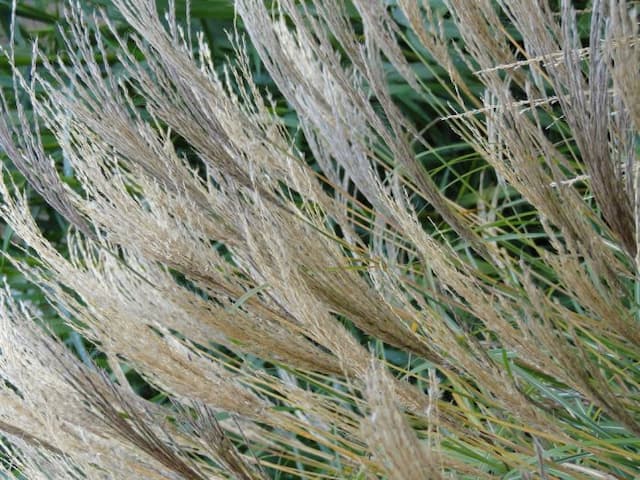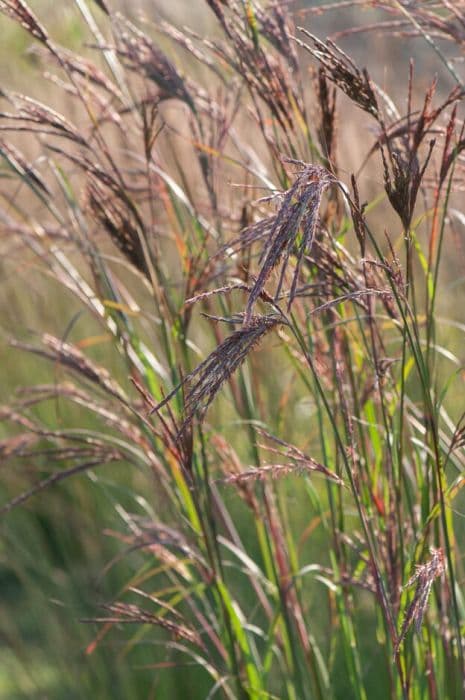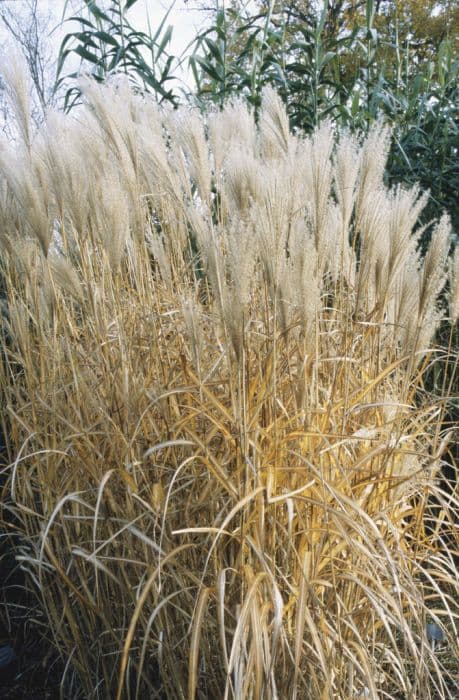Desert Needle Grass Stipa splendens Trin.

ABOUT
Stipa splendens Trin., commonly known as the desert needle grass, is a species of grass native to dry, open landscapes. When describing its appearance, we focus on its overall shape and the characteristics of its foliage and flowering structures. The plant displays a dense tufted habit, with numerous stems emerging from a central point. The leaves are generally long and fine-textured, exhibiting a bluish-green or grayish-green color that adds to its unique visual appeal. The desert needle grass is especially admired for its inflorescences, the complex flower structures, which present a delicate and feathery look. These flowering spikes are topped with long, hair-like awns that glisten under the sunlight, giving the plant a graceful and shimmering aspect. The awns may start with a pale green color and later turn into a golden hue as they mature. The combination of its elegant leaves and the radiant flowering spikes creates a soft, flowy appearance that sways with the wind, adding a sense of motion to the landscape. This contributes to its decorative value in naturalistic plantings and xeriscape gardens, where it offers both visual interest and adaptability to harsh conditions.
About this plant
 Names
NamesFamily
Poaceae
Synonyms
Desert Needlegrass, Splendid Needlegrass, Splendid Tussockgrass
Common names
Stipa splendens Trin.
 Toxicity
ToxicityTo humans
The plant Stipa splendens Trin., commonly known as the Giant Feather Grass, is not widely recognized for its toxicity to humans. There is a lack of substantial evidence indicating that this species poses a significant toxic risk upon ingestion. However, it is always advisable to exercise caution and avoid eating plants not known to be safe, as individual sensitivities and allergic reactions can occur. In the event that any part of the plant is ingested and adverse symptoms are experienced, it is recommended to seek medical attention promptly.
To pets
Giant Feather Grass is not commonly known to be toxic to pets. However, as with humans, pets can also have individual sensitivities or allergic reactions to plants that are otherwise not considered poisonous. Care should be taken to prevent pets from ingesting this or any unknown plants, and if any symptoms of illness are observed following ingestion, it is important to consult a veterinarian. In general, the ingestion of non-toxic plant material by pets could potentially cause mild gastrointestinal upset depending on the amount consumed and the pet's overall health.
 Characteristics
CharacteristicsLife cycle
Perennials
Foliage type
Deciduous
Color of leaves
Green
Flower color
Varies
Height
2-3 feet (0.6-0.9 meters)
Spread
2 feet (0.6 meters)
Plant type
Grass
Hardiness zones
7
Native area
North America
Benefits
 General Benefits
General Benefits- Ornamental value: Stipa splendens, commonly known as feather grass, adds aesthetic beauty to landscapes with its delicate, feathery plumes.
- Erosion control: Feather grass has a deep root system that helps stabilize soils and prevent erosion.
- Drought resistance: Adapted to arid conditions, feather grass is a drought-tolerant species, reducing the need for irrigation.
- Wildlife habitat: The plant provides cover and nesting material for birds and other small wildlife.
- Low maintenance: Once established, feather grass requires minimal care, making it a good choice for low-maintenance gardening.
- Seasonal interest: With its changing colors and textures throughout the year, feather grass offers varied seasonal interest in the garden.
 Medical Properties
Medical PropertiesThis plant is not used for medical purposes.
 Air-purifying Qualities
Air-purifying QualitiesThis plant is not specifically known for air purifying qualities.
 Other Uses
Other Uses- Stipa splendens, commonly known as Needlegrass, can be used as accent plants in landscaping for their unique texture and movement.
- The dried stems and flower heads of Needlegrass are often incorporated into floral arrangements for a rustic or natural aesthetic.
- Needlegrass can be integrated into erosion control projects, as their root systems can help stabilize the soil.
- Used in crafting, the stiff stems of Needlegrass can be woven into small decorative items such as bookmarks or coasters.
- They may be utilized in auditory garden spaces, where the rustling sound of their leaves in the wind adds a calming, sensory dimension.
- Needlegrass can act as an indicator species in certain habitats, helping to identify the health of an ecosystem.
- The seeds of Needlegrass are sometimes used in seed art or mosaics for their unique shape and texture.
- Needlegrass can provide habitat and protection for small wildlife, such as insects and ground-nesting birds within a garden.
- Photographers can use stands of Needlegrass as a naturally occurring backdrop or feature in landscape photography.
- They may be used in educational settings for botany demonstrations due to their distinct inflorescence and growth habits.
Interesting Facts
 Feng Shui
Feng ShuiThe plant Stipa splendens is not used in Feng Shui practice.
 Zodiac Sign Compitability
Zodiac Sign CompitabilityThe plant Stipa splendens is not used in astrology practice.
 Plant Symbolism
Plant Symbolism- Resilience: Known for its ability to thrive in rough environments, Stipa splendens, commonly known as Needle Grass, often symbolizes the capacity to persist and remain strong through challenging times.
- Flexibility: As Needle Grass sways gracefully with the wind, it represents adaptability and the ability to bend without breaking when faced with external pressures.
- Elegance: With its fine, feather-like appearance, Needle Grass is often associated with beauty and grace, representing an effortless elegance in the plant world.
- Simplicity: The understated beauty of Needle Grass can symbolize the value of simplicity and the importance of focusing on the basics.
 Water
WaterDesert Needle Grass, commonly known as Stipa splendens Trin., requires minimal watering once established as it is adapted to arid conditions. It should be watered once every two to three weeks during the hot season and less frequently, if at all, during cooler months, unless it's showing signs of drought stress. When watering, it is crucial to deeply saturate the soil, using about 1-2 gallons of water, depending on the size and maturity of the grass. During the winter, rainwater alone can often be sufficient, and additional watering can be completely withheld if adequate rainfall is received.
 Light
LightDesert Needle Grass thrives in full sunlight, making it ideal for spots that receive at least six hours of direct, unfiltered sunlight daily. Its preference for abundant light makes it well-suited for open landscapes, away from larger plants or structures that may cast shade. Limited shade is tolerated by this plant, but its growth and health are optimal in full sun conditions.
 Temperature
TemperatureDesert Needle Grass is heat-tolerant and prefers the warm temperatures typically found in arid and semi-arid regions. It can survive in temperatures as low as 20 degrees Fahrenheit and as high as 100 degrees Fahrenheit. For optimal growth, maintaining an environment where the temperature consistently stays between 70 and 90 degrees Fahrenheit is ideal.
 Pruning
PruningPruning Desert Needle Grass is primarily done to remove dead foliage and maintain appearance. To keep the plant healthy and looking its best, prune it back by about one-third in the late winter or early spring before new growth begins. This annual pruning will help stimulate fresh growth and prevent the grass from becoming too woody.
 Cleaning
CleaningAs needed
 Soil
SoilThe plant commonly known as Desert Needlegrass prefers a soil mix with good drainage, typically a sandy or loamy composition. The best soil pH for Stipa splendens is slightly acidic to neutral, ranging from 6.0 to 7.5. Amending the soil with organic material like compost can also benefit plant health.
 Repotting
RepottingDesert Needlegrass, or Stipa splendens, typically does not require frequent repotting. It should be repotted only when it outgrows its container, which is usually every 2 to 3 years to refresh the soil and provide more room for growth.
 Humidity & Misting
Humidity & MistingDesert Needlegrass thrives in dry environments and does not require high humidity levels. It is well adapted to arid conditions; therefore, the best humidity level for Stipa splendens would be on the lower end, mirroring its natural habitat.
 Suitable locations
Suitable locationsIndoor
Place Desert Needlegrass in a sunny spot with well-draining soil.
Outdoor
Plant Desert Needlegrass in full sun with well-drained soil.
Hardiness zone
7-11 USDA
 Life cycle
Life cycleStipa splendens Trin., commonly known as splendid feather grass, begins its life cycle as a seed, which upon finding suitable soil and moisture conditions, germinates typically in the spring or autumn. The seedling then develops a primary root and shoots, emerging above the soil as it enters the vegetative stage, producing tillers and developing a robust root system. As the plant matures, it reaches the reproductive stage, characterized by the formation of inflorescences, or flowering parts, which eventually lead to pollination and fertilization. After successful fertilization, the plant produces seeds that are carried by the wind, due to the feathery nature of the seed appendages. Over time, as the plant ages and environmental conditions may become unfavorable, it enters a period of senescence, wherein growth slows and parts of the plant may die back. Once the life cycle is complete, the plant dies, but leaves behind seeds which ensure the continuation of the species.
 Propogation
PropogationPropogation time
Spring-Early Summer
The most popular method of propagation for Stipa splendens Trin., commonly known as Giant Feather Grass or Splendid Feather Grass, is by seed. Seeds can usually be sown in late winter to early spring, depending on the local climate conditions, in well-draining soil. The process involves spreading the seeds over the surface of the soil and pressing them lightly into the substrate without covering them, as they need light to germinate. It is critical to keep the soil moist but not waterlogged during the germination period. Optimal germination temperatures are around 55 to 65 degrees Fahrenheit (12 to 18 degrees Celsius). Seedlings emerge in approximately 2 to 3 weeks and can be transplanted outdoors once the risk of frost has passed and they have grown strong enough to withstand the elements.









